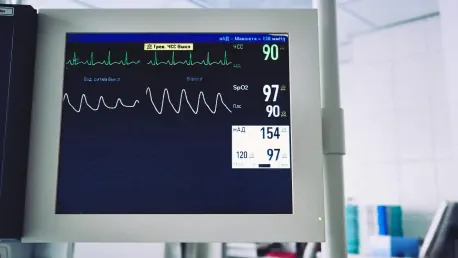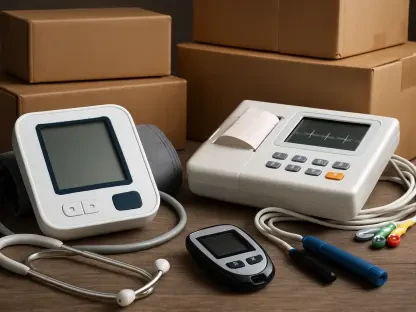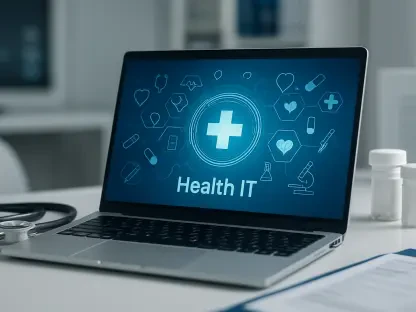The global Medical Device Security Market is set to experience robust growth, with projections indicating a Compound Annual Growth Rate (CAGR) of 8-10% by 2027. This growth trajectory is being driven by several key factors, including the increasing prevalence of connected and wearable medical devices, a rise in cyber-attacks, an expanding geriatric population, and a corresponding uptick in chronic diseases. However, the market’s expansion is not without its challenges, as limited budgets for healthcare device security remain a significant obstacle that could impact growth.
Increased Connectivity of Medical Devices
The healthcare sector is witnessing a substantial increase in the utilization of connected medical devices, such as wearables and remote monitoring systems. Advances in healthcare technology have considerably enhanced patient outcomes and the operational efficiency of healthcare systems. As more medical devices become networked, the potential for cyber-attacks also rises, necessitating stringent security measures to protect sensitive patient data. For instance, GE Healthcare launched ReadySee Asset Management & Network Supervision Solutions in April 2023, aimed at enhancing device security protocols without compromising patient care standards.
The growing connectivity of medical devices brings numerous benefits, including real-time monitoring and improved patient management. However, it also introduces vulnerabilities that malicious actors can exploit. The healthcare industry is increasingly aware of the need for comprehensive security measures to safeguard patient data. The increase in cyber threats emphasizes the critical need for medical device security, as unauthorized access to medical devices can lead to severe ramifications, including the potential manipulation of patient treatments and diagnoses. Consequently, investments in robust cybersecurity frameworks are becoming an essential part of healthcare infrastructure.
Post-COVID-19 Impact
The impact of the COVID-19 pandemic on the healthcare sector has been profound, accelerating the adoption of connected devices and heightening the need for robust cybersecurity solutions. The widespread use of telemedicine and remote monitoring during the pandemic underscored the necessity of secure cybersecurity protocols to protect patient data, driving significant demand for medical device security solutions. The pandemic served as a catalyst, raising awareness among healthcare organizations regarding the risks associated with cyber-attacks and the importance of implementing comprehensive security measures.
Government initiatives and increased investments in healthcare IT have further supported this market growth. For example, Cisco’s launch of Cisco Cyber Vision in February 2023 provided organizations with comprehensive visibility into IT and OT devices, enabling them to mitigate threats and ensure unified security across networks. Additionally, Secure Equipment Access Plus was introduced to streamline the remote deployment, management, and troubleshooting of connected equipment, further enhancing security measures in the healthcare sector. These developments highlight the industry’s commitment to adopting advanced cybersecurity solutions in response to growing threats.
Regional Market Dynamics
North America currently holds a dominant position in the medical device security market, driven by several factors, including high demand for connected medical devices, the frequent occurrence of cyber-attacks, government initiatives focused on cybersecurity, and the presence of key market players. The region’s robust healthcare infrastructure and proactive approach to cybersecurity have positioned it as a leader in the medical device security landscape. Investments in healthcare IT and continuous advancements in technology have further solidified North America’s market dominance.
In contrast, the Asia-Pacific region is expected to witness significant growth in the coming years. Factors contributing to this growth include the increasing adoption of connected medical devices, a high rate of cyber-attacks, and increased awareness among healthcare professionals about the importance of cybersecurity solutions. Regional governments are also playing a crucial role by implementing regulations and initiatives to bolster cybersecurity measures. The growing awareness of data breaches and the need to protect patient health information are driving demand for advanced security solutions, positioning the Asia-Pacific region as a key growth market for medical device security.
Competitive Landscape and Strategic Initiatives
The competitive landscape of the medical device security market is characterized by the presence of key players such as Cisco Systems Inc., IBM, GE Healthcare, Philips Healthcare, Check Point Software Technologies, FireEye Inc., and Palo Alto Networks Inc. These companies are actively pursuing various growth strategies, including the launch of new and upgraded products, forming strategic collaborations, and undertaking acquisitions to enhance their market share. For instance, Palo Alto Networks introduced Medical IoT Security in December 2022, a comprehensive Zero Trust security solution for medical devices, demonstrating the industry’s focus on innovation and security.
Market players are continuously investing in research and development to stay ahead of emerging cyber threats and enhance their security offerings. Collaborations between technology companies and healthcare providers are also on the rise, aimed at developing integrated security solutions that address the unique needs of the healthcare sector. These strategic initiatives are essential for staying competitive in a rapidly evolving market. The commitment of key players to enhancing their security solutions through innovation and collaboration is expected to drive the market forward, ensuring the protection of patient data and the secure operation of medical devices.
Market Trends and Future Outlook
The global medical device security market is poised for continued momentum in the coming years. Factors such as the growing adoption of connected medical devices, significant investments in healthcare IT infrastructure, ongoing product developments by major firms, and the implementation of vigorous growth strategies by market players are expected to drive this momentum. Notable trends include an increased focus on cybersecurity to address rising cyber threats targeting medical devices and the integration of advanced technologies to enhance security and operational efficiency in healthcare systems.
The future outlook for the medical device security market is promising, with technological advancements playing a critical role in shaping its trajectory. Innovations such as artificial intelligence (AI) and machine learning are anticipated to enhance threat detection and response capabilities, providing more robust security solutions. Additionally, the development of blockchain technology for secure data sharing and the implementation of Zero Trust security models are expected to further strengthen the market. As the healthcare sector continues to evolve, the emphasis on comprehensive security measures will remain paramount in ensuring the protection of patient data and the integrity of medical devices.
Summary and Forward Steps
The global Medical Device Security Market is poised for significant expansion, with a projected Compound Annual Growth Rate (CAGR) of 8-10% by 2027. This growth is being fueled by a variety of factors, including the increasing use of connected and wearable medical devices, a rising number of cyber-attacks on the healthcare sector, an aging population, and a subsequent increase in chronic conditions. These elements collectively drive the demand for enhanced security measures in medical devices.
Nevertheless, the market’s growth faces certain hurdles, chief among them being limited budgets allocated for healthcare device security. Financial constraints in the healthcare sector could significantly impact the implementation and adoption of comprehensive security solutions, potentially slowing down the market’s expansion. Despite these challenges, the urgency to protect sensitive medical data and ensure patient safety is likely to spur innovation and investment in the sector, driving the market forward.









